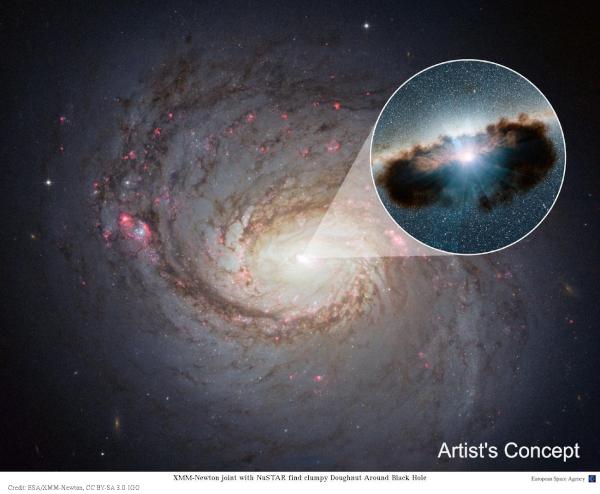Joint XMM-Newton and NuSTAR observations reveal clumpy Doughnut Around Black Hole

Minimum credit line: Image courtesy of ESA. (for details, see Conditions of Use).
Credit: ESA/XMM-Newton, CC BY-SA 3.0 IGO
The image above can be displayed at full size and may be downloaded by clicking the image above.
| About this Image |
|---|
The most massive black holes in the universe are often encircled by thick, doughnut-shaped discs of gas and dust, also known as torus. This deep-space doughnut material ultimately feeds and nourishes the growing black holes tucked inside.
Depending on viewing angle, any light emitted from the nearest vicinity of the black hole can be blocked by the torus (edge on view), or all light can be seen (face on view). This idea is referred to as the unified model because it neatly joins together the different black hole types, based solely upon orientation.
NGC 1068 is a so-called obscured AGN, i.e., an Active Galactic Nucleus seen from the side, thus no direct emission from the central black hole can be seen from Earth. However, during a coordinated XMM-Newton plus NuSTAR observation in August 2014, NuSTAR observed a spike in brightness which was not seen in the simultaneous XMM-Newton observation. Since NuSTAR observes X-rays in a higher-energy range than XMM-Newton, those high-energy X-rays can uniquely pierce thick clouds around the black hole, and the spike only in high-energy X-rays can be explained as due to a temporary clearing in the thickness of the material entombing the supermassive black hole. This interpretation then indicates that the torus is not uniform in density but clumpy.
Investigator(s): Andrea Marinucci
| For More Information |
|---|
- Read the Press Release
- Read the Journal article
- Detailed description of this image
- Query XSA archive for XMM-Newton data in the field of NGC 1068
- Astronomical database entries for NGC 1068;
- Query NED for more images about NGC 1068
- Query SIMBAD for more NGC 1068 data
- For unfamiliar terms, visit the XMM-Newton Astronomical Glossary
| Instrument | EPIC pn | ||
| Observing Mode | Full Frame | ||
| Filter | Medium | ||
| Date of Observation | 2014-08-19 | ||
| Image size | 35.00 x 35.00 arcmin | ||
| Detailed Caption | The team says that future research will address the question of what causes the unevenness in doughnuts. The answer could come in many flavors. It's possible that a black hole generates turbulence as it chomps on nearby material. Or, the energy given off by young stars could stir up turbulence, which would then percolate outward through the doughnut. Another possibility is that the clumps may come from material falling onto the doughnut. As galaxies form, material migrates toward the center, where the density and gravity is greatest. The material tends to fall in clumps, almost like a falling stream of water condensing into droplets as it hits the ground. "We'd like to figure out if the unevenness of the material is being generated from outside the doughnut, or within it," said Gandhi. "These coordinated observations with NuSTAR and XMM-Newton show yet again the exciting science possible when these satellites work together," said Daniel Stern, NuSTAR project scientist at NASA's Jet Propulsion Laboratory in Pasadena, California. |
||
| Alternate Resolutions | (Help) |
|---|
This image is available in the following downloadable versions: Higher resolution versions of this image may be available, please contact the XMM-Newton HelpDesk.
Search the Image Gallery
To search the Image Gallery for a particular object, fill in the object name in the box below and click the Submit button.To search the Image Gallery for other images, fill in any of the fields below and click the Submit button.
For more search options, please use our Advanced Search form.